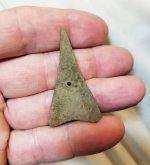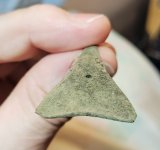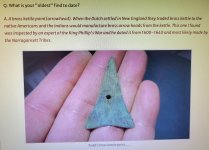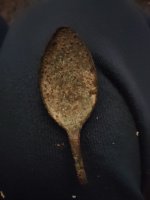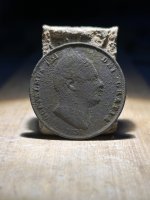- Mar 30, 2020
- 419
- 2,768
- Primary Interest:
- All Treasure Hunting
On New Year's Day I found this copper kettle arrowhead while metal detecting on eastern Long Island, NY. I posted it over on the metal detecting forum so please excuse the repeat. I've never really checked out this forum before and am finding it very interesting.
My main goal when I started metal detecting over three years ago was to find objects dating back to the 1600's when the area where I live was first settled by Europeans. My oldest coins to date are two 1722 and one 1723 King George I. Mostly KGII era finds. I could have buttons and other objects dating to the 1600's, but nothing definitive. Colonial population was sparse and access to properties to detect is difficult so the challenge is huge.
This find lead me to spending hours researching copper points. The ones I've seen from digs in upstate NY are usually basic flat equilateral triangles with the hole for hafting. This one shows nice craftsmanship. I haven't even rinsed it off. I stumbled upon a blog entry from 2017 in Stout Standard's Q & A with Todd Hiltz. His point is a near perfect match and if you read the text above, was thought by an expert to be Narragansett dating from the early to mid-1600's. The historical contact period didn't last long so these finds are interesting. Huge epidemics, mostly smallpox, devastated the majority of Native populations in the New England region beginning in the early 1600's through early 1700's. Plus they wanted to get their hands on guns as soon as possible and gave up the bow.
I research European colonialism and have been looking for this early culture. It was a pleasant surprise to find an artifact that is a blend of European and Native Cultures. I discovered this book (photo attached) on the Puritan and Native struggles of 1600's New England. I only had a basic understanding of this history. Now I am reading about the Narragansett, the powerhouse tribe of the region, their acquisition of trade metals for tool-making, and raids to the this area during the mid-1600's where I now live. The Montaukett were in the Narragansett sphere and paid protection money in fine locally crafted wampum. When the Narragansett raided eastern Long Island this allowed the British to take sides in the conflict and settle. I'm reaching out to the author of this book as I'm sure he will really appreciate seeing it.
My main goal when I started metal detecting over three years ago was to find objects dating back to the 1600's when the area where I live was first settled by Europeans. My oldest coins to date are two 1722 and one 1723 King George I. Mostly KGII era finds. I could have buttons and other objects dating to the 1600's, but nothing definitive. Colonial population was sparse and access to properties to detect is difficult so the challenge is huge.
This find lead me to spending hours researching copper points. The ones I've seen from digs in upstate NY are usually basic flat equilateral triangles with the hole for hafting. This one shows nice craftsmanship. I haven't even rinsed it off. I stumbled upon a blog entry from 2017 in Stout Standard's Q & A with Todd Hiltz. His point is a near perfect match and if you read the text above, was thought by an expert to be Narragansett dating from the early to mid-1600's. The historical contact period didn't last long so these finds are interesting. Huge epidemics, mostly smallpox, devastated the majority of Native populations in the New England region beginning in the early 1600's through early 1700's. Plus they wanted to get their hands on guns as soon as possible and gave up the bow.
I research European colonialism and have been looking for this early culture. It was a pleasant surprise to find an artifact that is a blend of European and Native Cultures. I discovered this book (photo attached) on the Puritan and Native struggles of 1600's New England. I only had a basic understanding of this history. Now I am reading about the Narragansett, the powerhouse tribe of the region, their acquisition of trade metals for tool-making, and raids to the this area during the mid-1600's where I now live. The Montaukett were in the Narragansett sphere and paid protection money in fine locally crafted wampum. When the Narragansett raided eastern Long Island this allowed the British to take sides in the conflict and settle. I'm reaching out to the author of this book as I'm sure he will really appreciate seeing it.
Attachments
Upvote
14



